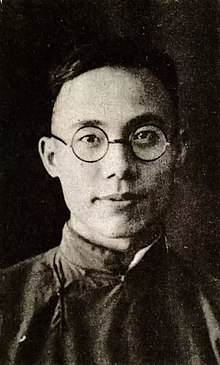Fang Ganmin
Fang Ganmin | |
|---|---|
| Phương càn dân | |
 Fang Ganmin, c. 1930 | |
| Born | 15 February 1906 |
| Died | 21 January 1984(aged 77) |
| Nationality | Chinese |
| Known for | Painting, drawing,sculpture |
| Movement | Cubism,Chinese Modernism |
| Spouse | Su Ailan ( tô ái lan ) |
| Fang Ganmin | |||
|---|---|---|---|
| Traditional Chinese | Phương càn dân | ||
| Simplified Chinese | Phương càn dân | ||
| |||
Fang Ganmin(simplified Chinese:Phương càn dân;traditional Chinese:Phương càn dân;15 February 1906 - January 1984) was a Chinese French-trained painter, sculptor and educator, who was educated in Paris and spent most of his adult life in China. Regarded as one of the pioneers of Chinese oil painting, Fang was born in theWenlingcounty,Zhejiangprovince. He began studying painting in 1924 and went to Paris in 1925, enrolling in theÉcole nationale supérieure des Beaux-Arts,making him one of the first-generation Chinese painters to study abroad in France. Upon returning to China, he taught at theNational Arts Academy,Hangzhou,becoming a professor at the Western Painting Department.[1][2]During theCultural Revolution,Fang was shamed and tortured by theRed Guards,and his works were destroyed. He died in 1984. His students includeZao Wou-Ki,Chu Teh-Chun[3]andWu Guanzhong.[4]

Timeline
[edit]In 1906, Fang Ganmin was born in Wenling, Zhejiang on February 15. His father, Fang Yue (also known as Xun Cheng), was an official literary degree holder, who majored in the study of written characters and published several books including "A Simple Approach to The Study of The Six Classes of Characters".
In 1920, Fang attended Andin High School in Hangzhou, gradually showing his talent in art.
In 1924, he went to Shanghai in the summer to apply for the Shanghai Academy of Fine Arts and was accepted to the second level where he was educated with a solid drawing foundation under the direction of Russian teacher V. Podgursky.
In 1925, he left Shanghai for France to further his studies.
In 1926, after learning the French language at a town outside Paris for six months, Fang was accepted into an art school in Lyon where he took "Paster Casts" and "Future drawing" classes.
In 1927, Fang attended École des Beaux-Arts de Paris and joinedJean-Paul Laurens' studio, together withYan Wenliang.Apart from taking drawing lessons at the studio, he was also a frequent visitor of galleries and museums and developed a strong interest in post-impressionism.
In 1929, he married Ms. Ai Lan Su, his fellow schoolmate at École des Beaux-Arts, in Paris. He returned to China in the winter and was hired by the Shanghai Private Xin Hua Fine Arts Academy, but later transferred to Shanghai Fine Arts University and Shanghai Academy of Fine Arts. Fang met Su Ailan at the Beaux-Arts in the Humbert Studio (the only one authorised to receive female students).[5]
Career
[edit]Fang Ganmin studied in Shanghai Meizhuan and underJean-Pierre Laurens(1875–1932), son ofJean-Paul Laurens(1838 – 1921), at the École nationale supérieure des Beaux-Arts, from 1926 to 1929, together with Chinese artists such asYan Wenliang.He taught in Xinhua AFA, Shanghai, and Hangzhou Academy.[6]
In or around 1930, Fang Ganmin, along with artists such as Xu Shaozeng, Guo Guni, Li Jingfa and Zhu Yingpeng, founded the Changfeng Society for the Study of Western Paintings.[7]
In 1951 and 1952, a campaign against modernist art, condemned in Soviet terms as both bourgeois and formalist, had forcedLin Fengmianand Wu Dayu to leave the art academy in Hangzhou and return to Shanghai.Realismwas deemed the progressive style. Fang Ganmin managed to remain, but was nonetheless marginalised and condemned for his modern styles.[8]
During theCultural Revolution,Fang, branded an anti-revoluntary for his modernist artistic style, was paraded around the National Academy of Art in Hangzhou, ink and paint poured over him as students beat and denounced him. Fang was also imprisoned by theRed Guardsfor long periods.[9]
Lin Fengmian,Wu Dayu and Fang Ganmin, and their studentsChu Teh-Chun,Wu Guanzhong,andZao Wou-Ki,have been collectively referred to the "West Lake" school of artists ( tây hồ họa phái ).
Works
[edit]
Of Fang's early paintings, two are particularly noteworthy. They are exercises in theCubistmanner, and give to their subject, both nudes, the geometrical and sculptural, but not the fragmented, effect of a picture byBraque.One of them is ''Melody in Autumn'' (1934). The other is "White Doves" (1932), which portrays geometric shapes suggestive of Cubism, but with an Art Deco-like structural undertone.
In jest, his students called his style fang (‘square’), punning on his surname Fang, which also happens to be one of the characters of the Chinese word for ‘cubic’.[10]
Notable students
[edit]- Chu Teh-chun
- Wu Guanzhong
- Zao Wou-ki
- Min Xiwen
References
[edit]- ^von Sarah Khan (27 March 2009).Globalisierende Kunstmärkte: Das Phänomen Kunst im 21. Jahrhundert aus globaler Perspektive. Zum Ende des hegemonialen Anspruchs des westlichen Kunstsystems und zum Anfang einer post-globalen Kultur.LIT VERLAG. pp. 113, 115, 116.
- ^Sullivan, Michael (1998).Art and Artists of Twentieth-century China.University of California Press. pp. 40, 301.
- ^"Thủy thiên trung: Chu đức quần hòa tha đích họa _ họa lang tân văn _ nhã xương tân văn".news.artron.net.Retrieved2018-02-02.
- ^Yasuko FURUICHI, cổ thị bảo tử (2006).Cubism in Asia: Unbounded Dialogues -- Report.Japan Foundation (Tokyo, Japan). pp. Presentation 2 of Session 1, Presentation 1 of Session 3.
- ^"Lé Van Dé, 1942, The Woman With The Dove, or the deconstruction, source of disillusionment".Jean-François Hubert's Blog.2022-02-28.Retrieved2023-10-09.
- ^Sullivan, Michael (2006).Modern Chinese Artists: A Biographical Dictionary.University of California Press. p. 86.
- ^Chan, Pedith Pui (2017).The Making of a Modern Art World: Institutionalization and Legitimatization of Guohua in Republican Shanghai.BRILL. pp. Appendix 2.ISBN9789004338104.
- ^Julia F. Andrews, Kuiyi Shen (2002).The Art of Modern China.University of California Press. pp. 62, 70, 142.
- ^"From Republican-Era Shanghai to Postwar Paris: Pan Yuliang's Bold Portraits".frieze.com.Retrieved2018-09-24.
- ^Pan, Lynn (2008).Shanghai Style:Art and Design Between the Wars.Hong Kong: Joint Publishing Hong Kong. p. 74.
